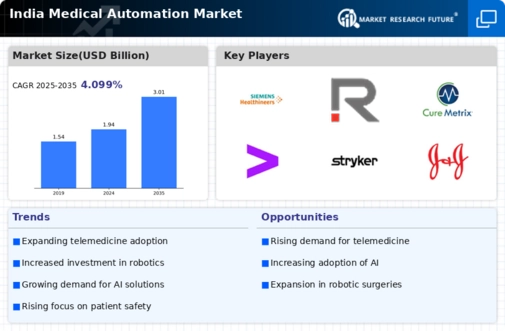The India Medical Automation Market is experiencing significant growth, driven by the increasing demand for efficient and effective healthcare solutions. As healthcare systems in India evolve, the emphasis on automation to improve service delivery, reduce operational costs, and enhance patient care is becoming increasingly paramount. The competitive landscape is characterized by a mix of established players and emerging companies, all vying for a share of this expanding market. Major trends influencing the sector include technological advancements, a growing preference for integrated healthcare solutions, and increasing investments in automation technology.
As players navigate this competitive terrain, their ability to innovate, cater to customer needs, and establish strategic partnerships becomes critical to their success. Companies are not only focused on product offerings but are also prioritizing customer experience and support services to gain a competitive edge.Siemens Healthineers has established a strong foothold in the India Medical Automation Market through its innovative solutions and extensive product portfolio.
The company is renowned for its advanced medical imaging technologies, laboratory diagnostics, and healthcare IT solutions, which have garnered widespread acceptance among healthcare providers in India. Siemens Healthineers leverages its global expertise to offer tailored solutions that address the specific challenges faced by the Indian healthcare sector. The company’s commitment to research and development ensures that it remains at the forefront of technological advancements, providing cutting-edge automation solutions that enhance efficiency and improve patient outcomes.
Additionally, Siemens Healthineers focuses on strategic collaborations and partnerships with local entities, further solidifying its market presence and enabling it to tap into regional opportunities effectively.RoboMed is another significant player in the India Medical Automation Market, recognized for its specialized robotic solutions and telemedicine platforms.
The company focuses primarily on automating clinical processes and remote diagnostic services, which have become increasingly relevant in the Indian healthcare landscape. RoboMed's product portfolio includes robotic-assisted surgical systems and software platforms designed to enhance clinical workflows and patient monitoring. The company's strengths lie in its ability to integrate advanced robotics with user-friendly interfaces, making it accessible to healthcare providers across various tiers. RoboMed's strategic initiatives, including mergers and collaborations with local healthcare institutions, have expanded its market presence and allowed for the development of tailored solutions that meet regional healthcare needs.
By continually enhancing its offerings and investing in local partnerships, RoboMed is positioning itself as a key player in driving medical automation advancements in India.












